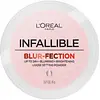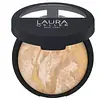L'Oreal Infallible Blur-Fection Loose Setting Powder Versus Laura Geller Baked Balance-N-Brighten Color Correcting Foundation
What's inside
What's inside
 Key Ingredients
Key Ingredients

 Benefits
Benefits

 Concerns
Concerns

 Ingredients Side-by-side
Ingredients Side-by-side

Zea Mays Starch
AbsorbentSynthetic Fluorphlogopite
Cellulose
AbsorbentLauroyl Lysine
Skin ConditioningCopernicia Cerifera Cera
EmollientSqualane
EmollientTocopherol
AntioxidantSodium Hyaluronate
HumectantHydrogen Dimethicone
Helianthus Annuus Seed Oil
EmollientCI 77163
Cosmetic ColorantCI 19140
Cosmetic ColorantCI 77491
Cosmetic ColorantCI 77492
Cosmetic ColorantCI 77499
Cosmetic ColorantCI 73360
Cosmetic ColorantCI 77007
Cosmetic ColorantMica
Cosmetic ColorantTalc
AbrasiveDimethicone
EmollientIsopropyl Palmitate
EmollientPolysorbate 20
EmulsifyingMagnesium Aluminum Silicate
AbsorbentTocopherol
AntioxidantCentella Asiatica Extract
CleansingCamellia Sinensis Leaf Extract
AntimicrobialSimmondsia Chinensis Seed Oil
EmollientEthylhexyl Methoxycinnamate
UV AbsorberTocopheryl Acetate
AntioxidantRetinyl Palmitate
Skin ConditioningPropylene Glycol Dicaprylate/Dicaprate
EmollientLauroyl Lysine
Skin ConditioningSodium Dehydroacetate
PreservativePhenoxyethanol
PreservativeBHT
AntioxidantNylon-12
Tin Oxide
AbrasiveCI 77891
Cosmetic ColorantIron Oxides
CI 77288
Cosmetic ColorantCI 77742
Cosmetic ColorantMica, Talc, Dimethicone, Isopropyl Palmitate, Polysorbate 20, Magnesium Aluminum Silicate, Tocopherol, Centella Asiatica Extract, Camellia Sinensis Leaf Extract, Simmondsia Chinensis Seed Oil, Ethylhexyl Methoxycinnamate, Tocopheryl Acetate, Retinyl Palmitate, Propylene Glycol Dicaprylate/Dicaprate, Lauroyl Lysine, Sodium Dehydroacetate, Phenoxyethanol, BHT, Nylon-12, Tin Oxide, CI 77891, Iron Oxides, CI 77288, CI 77742
 Reviews
Reviews

Ingredients Explained
These ingredients are found in both products.
Ingredients higher up in an ingredient list are typically present in a larger amount.
This ingredient comes from a fatty acid (lauric acid) and amino acid (lysine). It is used to add a silky feel to cosmetics.
According to a manufacturer, its fatty acid base leaves a silky feeling on the skin. It also has emollient properties because of this. Emollients help soften skin by preventing water from evaporating.
Lauroyl lysine is barely soluble in water.
Learn more about Lauroyl LysineTocopherol (also known as Vitamin E) is a common antioxidant used to help protect the skin from free-radicals and strengthen the skin barrier. It's also fat soluble - this means our skin is great at absorbing it.
Vitamin E also helps keep your natural skin lipids healthy. Your lipid skin barrier naturally consists of lipids, ceramides, and fatty acids. Vitamin E offers extra protection for your skin’s lipid barrier, keeping your skin healthy and nourished.
Another benefit is a bit of UV protection. Vitamin E helps reduce the damage caused by UVB rays. (It should not replace your sunscreen). Combining it with Vitamin C can decrease sunburned cells and hyperpigmentation after UV exposure.
You might have noticed Vitamin E + C often paired together. This is because it is great at stabilizing Vitamin C. Using the two together helps increase the effectiveness of both ingredients.
There are often claims that Vitamin E can reduce/prevent scarring, but these claims haven't been confirmed by scientific research.
Learn more about Tocopherol